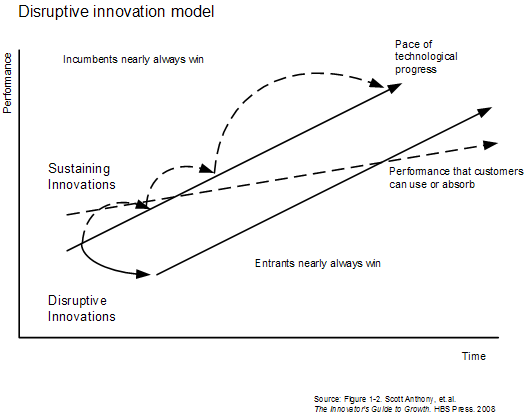[cross posted at FASTForward Blog]

The Innovator’s Guide to Growth is the newest installment in a series of books articulating and explicating Prof. Clay Christensen’s theory of disruptive innovation. This hands on guide packages some of the insights developed as an outgrowth of the consulting work of Innosight, LLC, the consulting firm founded by Christensen to pursue the practical insights from his research at the Harvard Business School. If innovation is part of your current or prospective job description, this needs to be on your shelf (after you’ve read it, of course).
Christensen’s theories of disruptive innovation appeared first with the publication of The Innovator’s Dilemma in 1997. During the worst excesses of the dotcom boom, every start up business plan including an obligatory head nod to Christensen and an assertion that their business model was truly disruptive. Who doesn’t want to be innovative; ideally disruptively so. Christensen and his colleagues have continued to develop his theories in The Innovator’s Solution: Creating and Sustaining Successful Growth, Seeing What’s Next: Using Theories of Innovation to Predict Industry Change, and now The Innovator’s Guide to Growth.
Christensen distinguishes two forms of innovation — sustaining and disruptive — not in terms of their technological features but in terms of their relationship to markets. The distinction in summarized in the following diagram reproduced from The Innovator’s Guide to Growth.
In essence, Christensen’s theory of disruptive innovation flows from recognizing that the pace of technology improvement is generally more rapid than the capacity of users in the market to take advantage of those improvements. This differential is what open possibilities for differing approaches to innovation.
In this market oriented theory of innovation, there are three paths available to organizations interested in articulating potentially disruptive strategies. The first is to identify and target “nonconsumers;” potential consumers for whom existing technologies fail to meet their particular needs. The second is to identify existing customers where existing technologies are more technology than they needs. The final is to investigate potential consumers in terms of what Christensen’s theory describes as “jobs to be done” as a path to defining new products and services to perform these jobs. I must confess that I still find this path the least well articulated aspect of this theory.
Throughout this book, the authors start by recapping the essentials of Christensen’s theoretical arguments and proceed to develop the next level of operational detail it takes to transform strategic insights into execution details. If you’re an organization seeking to develop its own disruptive strategy, the authors here have worked out many of the next level questions and identified the supporting analyses and design steps you would need to answer and complete. The authors are clearly competent and talented consultants who are willing to share how they manage and do their work. Their hope, of course, is that many of you will conclude that you need their help to do the work. What is nice here, is that they are confident enough in their abilities that they are quite thorough in what they share. This volume is not a teaser; it’s complete and coherent. You could pretty much take the book as a recipe and use it to develop your project plans. On the other hand, the plans by themselves won’t guarantee that you can assemble a team with the necessary qualifications to execute the plan successfully.
The other thing that this book does quite nicely is identify the kinds of organizational support structures and processes that you would want to put in place to institutionalize systematic disruptive innovation.
Christensen and his colleagues are continuing to build a rich, systematic, theory of disruptive innovation. With roots in academic research, they are freely sharing their insights and their methods. The Innovator’s Guide to Growth is a solid workbook that will let you develop your own skill at doing disruptive innovation. Of course, the plan by itself won’t eliminate the need to gain the experience for yourself. But it’s a lot better strategy than to have to work everything out from scratch on your own.

One thought on “A workbook on doing disruptive innovation effectively”
Comments are closed.